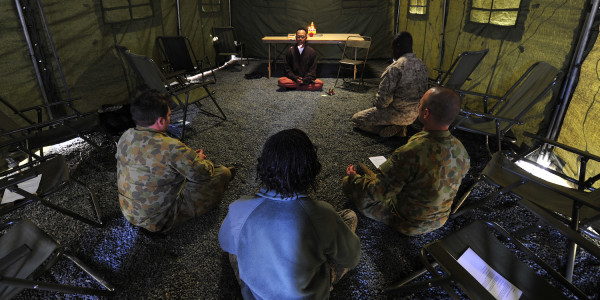

To those who do it there is a self-evident answer to that question: it works. How it works, why it works and for whom it works varies, but anyone who seriously practices zen meditation on a daily basis can usually experience the following: less stress, more focus and a general sense of well-being.
Beyond those basic benefits, meditation can be a transformative experience where the practitioner can gain insight into how his or her mind functions and perhaps even what the world looks like when it is stripped of all its non-essential elements.
There are many styles and school of meditation, including the practice of Christian contemplation and prayer. Each has its uses and achieves different results, but Zen meditation has its own unique practice which is perhaps best suited to the needs of a military man or woman.
Related: More veterans need to do yoga. Yes, really »
While posted in Afghanistan, I found meditation to be the strong starting point of every day. Very soon, the helicopters, the armed checkpoints, and the daily blast reports stopped being threatening and instead seemed just natural. I am not saying this is a good thing but much better than living under a feeling of constant threat.
The whole point of meditating in a stressful environment is to slow things down, get a handle on your inner mind, and to see things clearly so that if you are forced to respond you will do it appropriately and without hesitation.
To start out, you need to understand that Zen meditation is not a contest. You should not start doing it with a fixed goal in mind. Detachment from one’s ego and materialistic cravings is the essential starting point and we achieve that by a very simple process: just sitting.
That’s right. The benefits of meditation — and there are many — can be achieved by the simple act of finding a quiet spot in your environment where you can be alone, close your eyes, empty your mind and focus on your breathing. Of course, posture is important. Perhaps it’s best if you can sit in the classic “buddha” posture with legs folded while sitting on a cushion. If you can’t manage that then a chair is alright as long as you keep your spine erect and your head tilted slightly forward and the fingers of one hand cupped in the open palm of the other. The goal should be a feeling of balance and rootedness.
Now breathe. Or rather, start by counting your breaths until you get to 10, then start over again. Don’t worry if your mind wanders. Keep breathing and coming back to the counting. Most people will find this incredibly difficult to achieve at first. They want to hold on to their thoughts. They need to “work on things” in their head. In Zen, there is the idea of ‘chasing your thoughts’. That needs to be avoided. Let them rise and then fall. Imagine all of your thoughts like leaves falling from a tree. They are there, they are real, but they are passing. Behind them lies just emptiness.
Keep doing this. Stay seated in the meditation posture, focus on your breathing, let thoughts come and go, but keep coming back to your breathing. One. Two. Three.
If you can only do this for five minutes, then do it for five minutes. The best would be at least 30 minutes, perhaps when you first wake up in the morning. One hour twice a day would be best.
Over time, you will find that your perspective starts to shift. People and things that once bothered will lose their power over you. You will start to focus better on tasks at hand, on the things that you say and how you treat colleagues, friends and family. Another Zen expression says, “When you do zazen (meditation), the world does it with you.”
Zen is filled with ideas like this that need a little time to grasp, but the point is that “just sitting” in meditation every day, and not chasing your thoughts and not falling asleep, will make you a better person. And who wouldn’t benefit from that?
